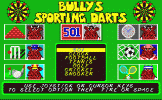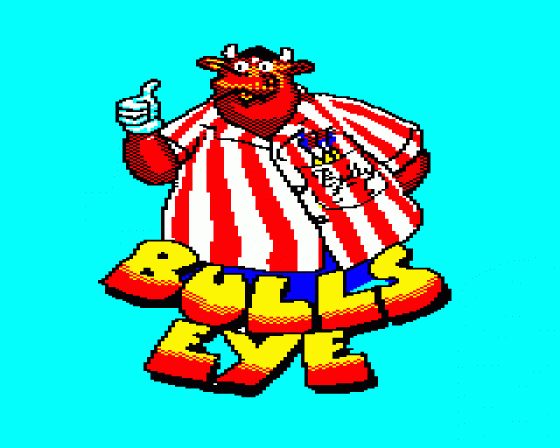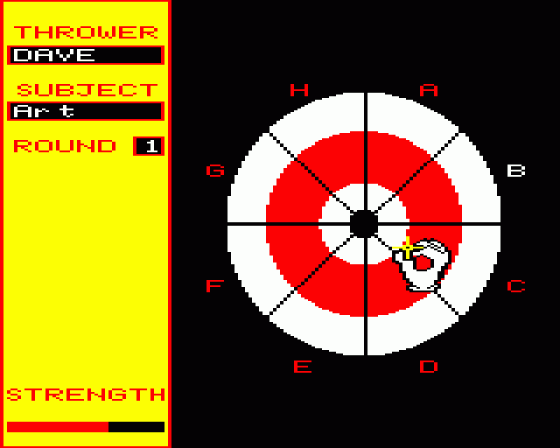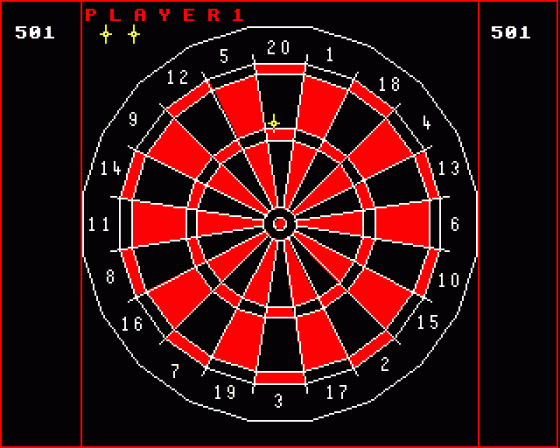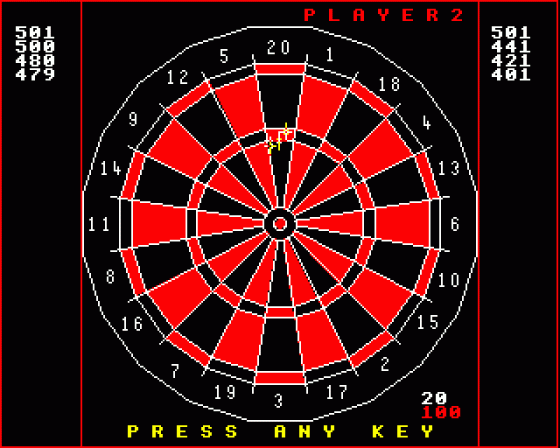Alternative Games Called Bully's Sporting Darts





| Genre: | Sport Game: Action |
| Publisher: | Alternative |
| Cover Art Language: | English |
| Machine Compatibility: | Spectrum 48K, Spectrum 128K |
| Release: | Professionally released on Cassette |
| Available For: | Amiga 500, Amstrad CPC464, Commodore 64 & Spectrum 48K |
| Compatible Emulators: | ZXSpin (PC (Windows)) Nutria (PC (MS-DOS)) |
| Original Release Date: | 24th November 1992 |
| Original Release Price: | £3.99 |
| Market Valuation: | £2.50 (How Is This Calculated?) |
| Item Weight: | 64g |
| Box Type: | Cassette Single Plastic Clear |
| Author(s): | Paul Griffiths |
Variant Items
There are 0 other items featuring this same game (that we know about!). Click any of them for their details.
Active Auctions
Closed Auctions
Buy It
Unfortunately no-one is currently selling this item.
Auction Price Watch
Worried you're being ripped off? Closing prices on eBay can help you decide what a reasonable price is for a particular item.

Sinclair User
16th December 1992
As far as computer darts games go, Bully fits the bill as well as any other one has in the past. The real problem is that it's not enough to keep you interested for any length of time. Read Review

Your Sinclair
1st March 1993
We haven't seen one of these for ages, and it's really well done with lots of sub-games. Unfortunately, only one of them's really any good and after a while the whole thing gets very boring indeed. Read Review
Full Instructions
Bully's Sporting Darts
Ole! Ole! Here it is at last, the ultimate darts game you'll be dying to get your horns into. A real beefy game that will have your friends charged up and stampeding around to your house to play.
Includes: Football, Golf, Snooker, Tennis and Cricket
The Game
This is a darts game with a difference, try your hand at any of the follwing: (All on special tailor-made dart boards!)
Football, Golf, Snooker, Tennis, Cricket
or:
the classics: 501 and Round The Board
This superb Alternative game has tremendous playability that will keep you coming back for more. No bull! Or, as Bully, the star of TV's Bullseye would say, "Moo-verlous!"
Selecting The Game
Move the highlight onto the desired game by using UP and DOWN and press FIRE to select the game. To see a demo of the game, press D instead of FIRE.
Choosing The Opponent
To play against a friend, type your own name as player one and your friend's name as player two. To play against the computer, type "COMPUTER" and a number between 1 and 9 as the second player's name. The number indicates the computer's skill level, for instance, typing "COMPUTER1" will make the computer an easy opponent.
Finishing A Game
When a game is finished, press RETURN or ENTER to go back to the menu. A game can be aborted at any time by pressing the "/" key.
The Dartboard
A standard dartboard is used, though in some games, such as football, only those segments that are needed are [some text missing]
The bullseye has an inner and outer "bed". The inner bull counts as a double, with the value 50, the outer bull has a value of 25. Radiating out from the centre are segments, each with a value from 1 to 20.
Half way out from the centre is the treble ring. A dart landing in a treble "bed" scores three times the segments normal value. On the outer edge of the segments is the double ring, a dart here doubles the normal value.
Throwing Darts
Practice makes (almost) perfect, as in a real game of darts. Controling the throwing hand can be tricky at first, but sensitive control via the joystick and pressing FIRE at the right moment to release the dart will produce a near perfect performance. However, to attain the perfect shot, a bit of luck is needed as in the real game.
If you take too long to play your shot, the computer will automatically release the dart for you, so watch the counter at the top of the screen if you are a player that likes to take their time. Players take it in turn to throw, with each "throw" normally consisting of three darts at the board.
501
This is the standard game of 501, the game consisting of the best of three legs. The game ends when one player has won two legs.
Each player's score begins at 501 at the start of a left, and is reduced by the value of each throw. To win a leg, a player must reduce his score to zero with a dart in a double. When a double would finish the game, it is highlighted on the board to help the players.
The standard rule of "bursting back" applies, that is, if a player throws more than is required, his throw is ended and his score reverts to the value at the start of the throw.
Round The Clock
This is the standard game of round the board where the player must hit each number in turn, starting at one and ending at the bull (inner or outer). The game is the best of three legs.
Doubles and trebles of the target number count as a single if they have a value greater than 20, otherwise they are counted as scoring the double or treble value. For instance, if 4 is required and double 4 is hit, it scores as 8 so that the next target is 9.
Football
Only the top half of the dartboard with the numbers removed is used in this game. The highlighted segment indicates the target number, when that number is hit, the highlight moves towards the opponents side by one two or three positions depending on whether the single, double or treble was hit.
When the highlight reaches the opponent's "goal area" coloured red or blue, the bull becomes highlighted and hitting an inner or outer bull will score a goal.
The game continues until the final whistle, the winning team being the one with the most goals.
Tennis
The tennis "ball" is represented by a highlighted "bed" on the dart board that must be hit with a single dart to return the ball.
As with real tennis, the server has a slight advantage over the receiver. The server always has a double "bed" as his target, where as the receiver has to hit trebles.
When serving, if the server fails to hit the target "bed" with his first dart, he has a second chance with his second serve.
A rally ends when a player fails to hit the ball, points are then awarded to the opponent in normal tennis fashion, ie 15, 30, 40 and game. Should the score reach 40 all (deuce), a player must gain advantage and then win the next rally to win the game.
A match consists of up to three sets, first to win two sets wins. Each set is scored as with real tennis, that is, a player must win six (or seven) games by two clear games. In the event of a tie at six games all, the last game is then a tie breaker.
In the tie breaker, service changes after every two rallies and points are awarded as 1, 2, 3, 4 etc. The first player to 7 or more by two clear points wins the game and set.
Golf
In this game, numbers 1 to 18 on the dartboard represent the 18 holes on a golf course.
The player has to get 3 of each number (or "hole") in turn starting at 1. The player progresses to the next "hole" only after he has finished the current "hole". Doubles and triples count as two and three of that number respectively.
A hole in one is achieved by hitting the treble with the first dart.
The number of "strokes" for each "hole" is the number of darts it takes to complete each one. The par for each hole is 3, making the par for the course 54.
The winner at the end of the course is the one with the lowest score.
Cricket
This game consists of two innings with the teams taking it in turn to be the batting and then the bowling side.
To start an innings, the batting side throws first, throws then alternate between batsmen and bowlers.
To score runs, the batting side must get at least 40 with three darts as only points above forty are counted. The bowling side must hit two bulls with three darts to take wicket. (Centre bull counts as two.)
Should the batting side hit a bull, they loose a wicket. Similary, if the bowling side throw a dart outside the treble ring, that score is credited to the batting side as wides. Should a bowler throw outside the doubles ring, 25 wides result.
The team with the most runs after two innings are the winners.
Snooker
The numbers 1 to 15 on the board represent the red balls, numbers 16, 17, 18, 19, 20 and bull represent the colours yellow, green, brown, blue, pink and black respectively.
To "pot" a red ball, three of a number representing a red ball must be hit in one throw. To pot a colour, four of that number must be hit. (Doubles and trebles count as two and three respectively in each case.)
As in a normal game of snooker, a red must be "potted" before each colour until all the reds are cleared, then each colour is "potted" in turn, ending at the bull for the black. If a player fails to "pot" a ball with a particular throw, his "break" is over, and the other player has a chance.
When reds are "potted", they are not returned to the "table" whereas "colours" are returned if reds are still available. When only colours are left on the "table", they disappear when potted in the right order.
Points are awarded (given away) to your opponent if you play a foul stroke. Missing a red (not hitting a red with any of your three darts) or potting a red instead of a colour gives 4 points away. Missing a colour, or potting a red instead of a colour gives 4 points away (or the value of the ball that should have been hit if this is greater).
If a player feels he can no longer win, pressing the C key while the throwing hand is stationary, ends the frame.
In the event of the scores being level at the end of a frame, the black ball is returned to the table, the first player to pot it then wins the frame.
The first player to win two frames is the winner.
Game Controls
O - Left, P - Right, Q - Up, A - Down, SPACE - Throw Dart
X - Abort Game
Loading
LOAD"" (ENTER)
To load the special 128K version, choose the correct side of the tape and select Tape Loader.
Miscellaneous
This game was mentioned in the following articles:
Screen Designers
The following utilities are also available to allow you to edit the supplied screens of this game:
Cheats
Download
A digital version of this item can be downloaded right here at Everygamegoing (All our downloads are in .zip format).
| Download | What It Contains |
|---|---|
| A digital version of Bully's Sporting Darts suitable for ZXSpin (PC (Windows)), Nutria (PC (MS-DOS)) |
Games Like Bully's Sporting Darts
Report A Problem
We thank you from the bottom of our hearts if you report something wrong on our site. It's the only way we can fix any problems!
You are not currently logged in so your report will be anonymous.
Add Note
Release Country
Change the country to update it. Click outside of this pop-up to cancel.
Scan Of Selected Article
If you auction an item, it will no longer show in the regular shop section of the site.


